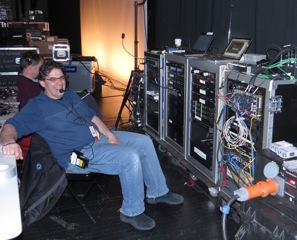Chicago-based Harpo Studios recently completed their multi-city Lifeclass tour stops in Toronto, New York and St. Louis. They produced one 2-hour live, plus one 2-hour taped, interactive talk shows featuring Oprah Winfrey, Deepak Chopra, Tony Robbins, Iyanla Vanzant and Bishop T.D. Jakes.
One of the challenges from the Toronto stop was the audio cabling from the Dome Productions broadcast truck to the stage was more than 1,200 feet. To overcome this they used three Roland Digital Snake Systems using Cat5e and converting to fiber for the audio transmission.
The Roland digital snake systems allows for the transmission of forty channels of high quality audio over a single cat5/6 cable bi-directionally, according to Rob Read, marketing communications manager, Roland Systems Group U.S. He explained to AV Technology magazine the benefit enjoyed by Oprah's Lifeclasses and anyone wanting to implement digital snakes into their audio workflow.
"The innovative REAC technology behind transmitting audio over ethernet cable ensures low latency and high quality audio immune from hums, buzzes, and RF interference found in traditional copper audio snakes," he said. "Additionally you have the ability to split audio by using ethernet switches providing multiple drop points around campuses, properties and venues. Using fiber optic converters transmissions of ethernet audio can be up to 1.2 miles in length ideal for stadiums, sporting events and broadcasting applications."
Harpo Studios’ audio production manager Gerry Formicola reports that for most of their stops on the multi-city tour, cable limitation was not really an issue because the runs they had to work through were 100 meters or less. Their standard digital snake equipment for the tour employs the Roland (S-4000S, S-0808, S-0816 and S-1608) digital snakes, along with the S-4000M REAC Merge Unit and S-MADI REAC MADI bridge. By using standard fiber converters For Oprah’s Lifeclass Tour’s Toronto episodes, they were able to use the Roland gear exactly as they had at other locations - plug-and-play.
According to Harpo Studios’ audio director J.R. Chappell, there were three Roland snake-enabled systems relied upon. First, they had the Roland S-4000S- 3208 digital snake that fed the Calrec FOH console using the S-4000H interface and the broadcast truck using the S-MADI bridge. The 2nd system implemented a pair of S-0808 snakes at each end, used for a separate set of lines back-and-forth for intercom purposes. For the 3rd digital snake system they used an S-1608 and an S-0816, one in the truck and one backstage for miscellaneous audio feeds back-and-forth between the truck and the stage.
Harpo Studios chose the Roland equipment for the tour because they knew it would simplify the cable runs. “We liked switching to digital when we were doing the remote shows, says Chappell, because oftentimes, with analog snakes, we would have problems with hums and buzzes or bad lines, and going digital completely eliminated those issues. We plugged in, and everything worked the first time and sounded great.”
Formicola states that what made it easy was that “we were able to get MADI, straight out of the system, and integrate that directly into the Calrec console on-board the broadcast truck. That was really helpful, as well.” He appreciates that the Roland S-0808, S-0816, and S-1608 digital snakes are “small, lightweight, and easy to put into a Pelican (or their own) case and move to a location.” In addition, he reports, they’re “simple, straightforward and super-easy to use.”
Formicola also attests that, having only had the units a short time, they’ve been rock-solid. “We’ve moved them from a studio environment to out in the field and back multiple times, and have not had one issue. Also, not having to pull cables makes things faster for us.”











